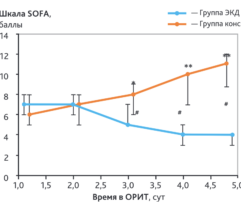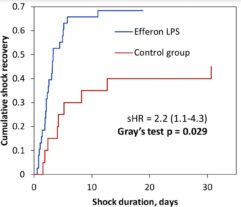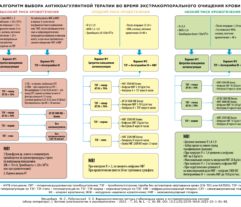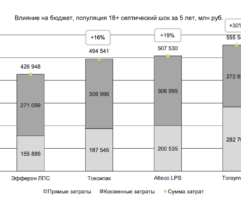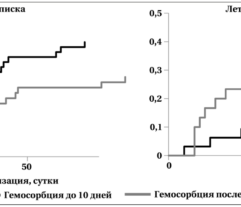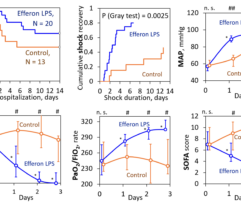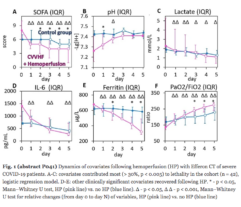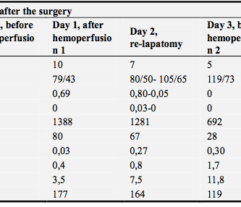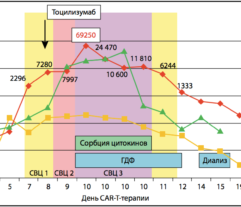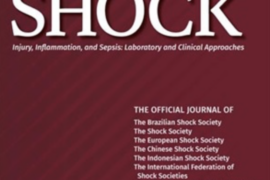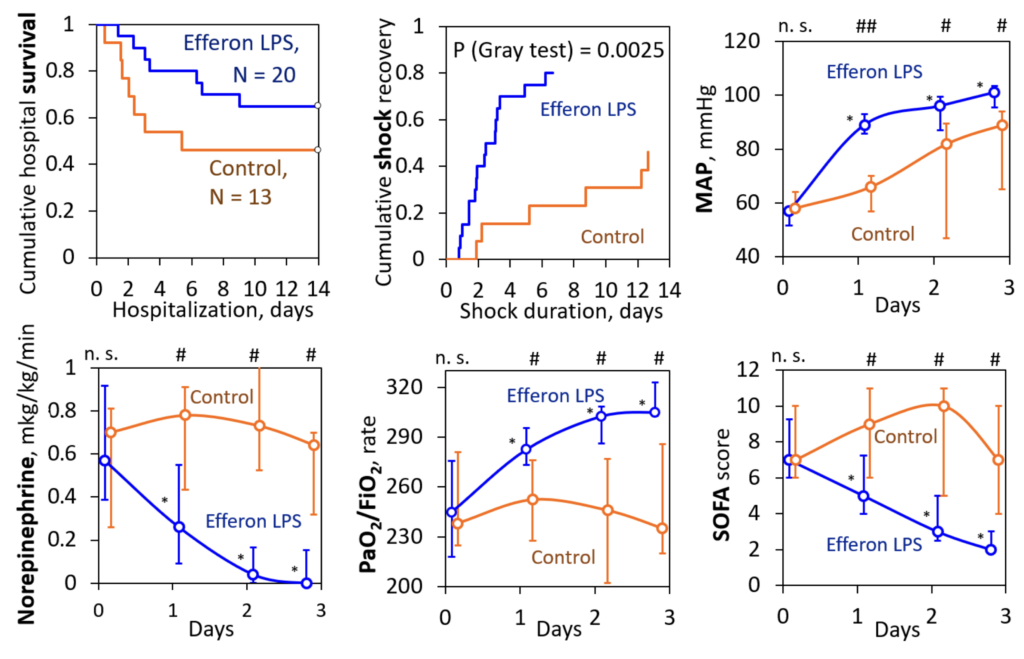
Introduction: post-surgery infections in ICU cause intra-abdominal sepsis (IAS) including septic shock associated with increased mortality. Rapid abrogation of endotoxin and\or excess of cytokines using extracorporeal hemoperfusion (EH) therapies may improve treatment outcomes in patients with septic shock [1-5].
Objectives: to evaluate the efficacy of the Efferon LPS device in extracorporeal therapy in patients with IAS complicated by septic shock.
Methods: thirty-three post-surgery patients admitted to the same ICU (20 men and 13 women, average body mass 88 kg, median age 67 years, range 39-89 years, with IAS, complicated by septic shock as revealed by SEPSIS-3(2016) criteria) were subdivided in two groups. One group received conventional treatment for septic shock (control, n=13), another one additionally underwent EH (n=20). EH was carried out by Efferon LPS adsorber containing cytoking-adsorbing mesoporous hypercrosslinked polystyrene beads with surface-immobilized LPS-selective ligand [5-8]. During three days, patients were receiving 1-2 EH procedures, a day apart, 4-6 hours each, using MultiFiltrate blood perfusion machine (Fresenius) at a rate of 100-150 ml/min, followed by continuous veno-venous hemodiafiltration. Groups did not differ significantly in age and sex, and in any of the parameters studied except PCT (Table, day 0). Statistical analysis was performed using Microsoft Excel with Real-Statistics add-in and XLStat (USA). Significance of intergroup differences was determined by Student’s t test, Wilcoxon test, or Mann-Whitney test, whatever appropriate, and significance of differences was considered at p<0.05.
Results: mortality during septic shock tended to decrease in EH patients vs.control group at a marginal significance (P=0.065). There was a trend in increased survival in 3, 7, and 14 days post- EH vs. control. EH resulted in a significant 4-fold decrease in septic shock duration in survived EH patients: 46(34-74) hours vs. 168 (71-272) hours (HE vs. control patients, respectively,cP=0.0025), accompanied by decreasing endotoxin and IL-6 levels, SOFA score, leukocyte, CRP, lactate and creatinine levels, whereas PaO2/FiO2 oxygenation index and MAP values were increasing. The most significant effects were revealed in patients <80 years old. EH led to rapid decreasing the multiple organ failure in patients exhibiting both lower (<8) and higher (>8) SOFA scores values. In contrast to a control group, on day 3 post-EH patients did not require norepinephrine support any more.
Conclusions: EH with Efferon LPS adsorber resulted in rapid improval of vital indices (SOFA, MAP, oxygenation index) and proinlammatory biomarkers (IL-6, PCT, CRP) in IAS patients associated with a rapid shock abrogation and a trend to decreasing mortality in an ICU setting.
1. Rachoin JS et al. Crit Care Explor. e0083, 2020.
2. Wei T et al. Medicine (Baltimore) 99: e19632, 2020.
3. Kogelmann K et al. Critical Care, 21:74-83, 2017.
4. Lipcsey M et al. Shock 54:224-231, 2020.
5. Ham SY et al. Sci Rep. 10: 21513, 2020.
6. Morozov AS et al. General Reanimatology 12:82-107, 2016.
7. Khoroshilov SE. et al. General Reanimatology 14: 51–60, 2018.
8. Ushakova ND et al. General Reanimatology 16: 14-20, 2020.

